BBC's Blog, page 24
March 20, 2013
iBroadcast: An easy way to publish AV content for the BBC
I'm Matthew Browning and among other things I'm executive product manager for BBC Future Media's Media Tools group.
Among the millions of daily visitors to bbc.co.uk how many stop to consider where the programmes, news and live coverage they are enjoying actually come from? This is where my team come in.
At the end of 2009, perhaps a little jaded from having been a technical lead on the first two versions of BBC iPlayer, I began to look after a team of four who were experimenting on the edges of iPlayer publishing.
We wanted to figure out how BBC desktop users might publish their AV content (clips and videos) onto the bbc.co.uk platform outside of the automated systems that had swelled to support iPlayer.
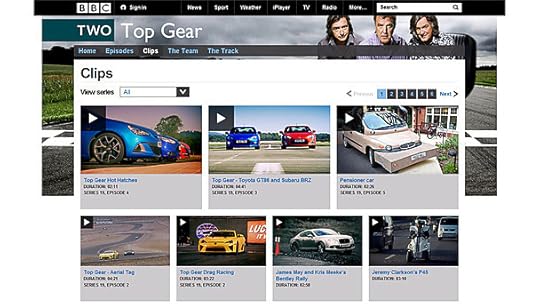
iBroadcast is used to upload video clips like this onto BBC programme pages
Previously online video had meant sourcing and encoding content yourself to whatever format seemed appropriate and getting a handy local web developer to help add it to your site.
We pieced together a funky-looking web application we called 'iBroadcast' (like 'iPlayer' - get it?) that acted as a kind of 'YouTube for the BBC'. That is to say it published video content for streaming through the BBC's Embedded Media Player outside of the broadcast schedule.
We worked with the producers of the BBC Comedy and Nature sites both of which had a significant requirement to publish off-schedule video such as previews of the latest comedy talent or fascinating footage from the Natural History Unit.
I'm willing to confess that I did not at that stage predict just how useful or popular our little app would prove to be.
Word soon got around to various pockets of the BBC that you could now publish your video without encoding hassles or the need for a web developer and a year later iBroadcast had over a thousand internal users who were now able to add long-term value to their programmes’ online offering.
It wasn't long before radio editors wanted a piece of the action. We made some simple updates to include transcode of audio material while at the same time expanding our range of outputs to extend beyond the PC experience , for example into IPTV products.
We also started to use iBroadcast officially to fill-in areas of the iPlayer schedule missing from automated workflows notably our Welsh television content, hand-published by the scheduling team in Cardiff.
We figured out how to hook our content into BBC iStats giving editors the opportunity, for the first time, to track traffic or views of their stuff. We published availability of our stuff in XML feeds, allowing automatic updates of our users’ web sites.
iBroadcast was cool but it was not without its problems. It became clear as requirements came flooding in that in focusing on short-form publishing we'd excluded the possibility of using the platform for anything else.
With iBroadcast’s roots in prototyping and hackery it was pretty far off-strategy for the BBC technology-wise. The infrastructure that we'd begged, borrowed and stolen from other BBC products was starting to creak under the strain of the relentless punishment from our editorial colleagues.
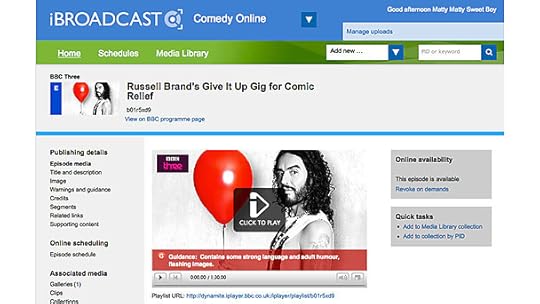
Uploading content into iBroadcast
It was time for a rethink. We knew we were working in a space that was only going to grow. With the help of a number of much cleverer people at the BBC I worked-up the strategy we live by today.
This meant, firstly, that our publishing tools should be developed with the same care and respect we would have for any other BBC product.
Secondly, a single supported platform should emerge to subsume all the existing, ad-hoc publishing solutions that had popped up around the organisation.
Finally, we were to broaden our vision to include all media-publishing requirements of the BBC.
The Autumn of 2011 saw the first release of iBroadcast 2. I yearned to change the corny name but the brand had so much approval among its users that it would have been madness to do so.
An engineer at heart, I'm deeply conscious of the second-system effect and I wanted to be sure that we weren't giving birth to a monster.
I did this by being ruthlessly clear that we were a media publishing solution, nothing else, and by espousing the principle of general utility in everything that we do before catering to the requirements of a specific BBC product.
iBroadcast 2.x was a re-think in terms of architecture as well as vision. We started to talk about building a product that was 'sexy' and after a while people stopped laughing at us.
We ensured a clear separation of concerns by delegating heavy-lifting and workflow management to a service layer capable of acting independently of the client.
The client itself is a PHP/Zend application mediating between service and user. While we've maintained a focus on accessibility for our users a modern-feeling usability is achieved through JQuery enhancements.
Our latest release is particularly exciting in that we address scalability and transcode speed by delegating our transcode and distribution to dedicated Cloud-based services.
This allows us to cope with more customers while dedicating computing power to the faster turn-around of submissions.
The multi-disciplinary Media Tools team of today has seats for twenty five people (we're hiring - get in touch if you want to join us) and maintains a product that manages all AV and image publishing at the BBC including catch-up.
We also provide tools to schedule and publish live events. If you watched any of the Olympic 2012 coverage you were enjoying our work.
We provided software that enabled the selection and scheduling of twenty four streams of live coverage as well as the editorial metadata needed to make sense of it.
Every BBC destination is now, to some extent, dependent on iBroadcast 2.x and we're a key ingredient for online propositions.
Matthew Browning is executive product manager for BBC Media Tools group, Future Media.
March 18, 2013
HD Test Card Special
Hi I’m Andy Quested, chief technologist HD & 3D, BBC Technology.
It’s been five years since my first blog about the BBC HD Channel and I can’t believe so much time has passed and so many things have happened since the channel and high definition began!
BBC Two HD starts on the 26 March and already several of you have spotted that this means the end of the test card and AV sync test signals.
The test card returned in December 2008 after a long break in a new ’turbo charged’ high definition format along with the brand new AV sync check signal.
The test signal package was added to the BBC HD promotion after we had many complaints about lip sync and ‘odd’ looking pictures. We took some time to have a long look at all the issues and suggestions coming in but we also looked at how the then new high definition televisions were set up when they were delivered.
The biggest issue was definitely lip sync however the complaints suggested we could have up to a four frame audio lead and a two frame video lead – often on the same programme and at the same time!
To get to the bottom of this a colleague from BBC Research and Development (BBC R&D) and I did an end to end sync check of the channel and all its processes. This included a couple of on-air tests to confirm the transmission encoders were not introducing sync errors.
We did find a couple of small problems and after they were corrected I could safely say the system was ‘alright arriving at you’ – a modification of the old engineering phrase ‘it’s alright leaving me’!
The test card and AV sync signal started to go out just before Christmas 2008 and were accompanied by my blog A Christmas Present from HD Channel that included help setting up new high definition televisions and the many (and varied) AV surround systems being attached.
I was very pleased to see a drop in lip sync complaints to virtually zero over the next few weeks. Now whenever we get complaints we can investigate the source, especially when people say they have confirmed their system is correct by using the test signal.
If you want to know more about the tests carried out and the processing involved, the BBC R&D White Paper is worth a read!
The last transmission of the BBC HD Channel promo is actually the morning of the 25 March through to the start of programming later that day. However, after the last programme at around 1.30am on the morning of the 26 (still to be confirmed) and the start of BBC Two HD programmes at 6.30am there is a gap and I made what would be called a ‘land grab’ for the time!
To say goodbye to the test signals we will be transmitting them continuously overnight!
To make it more interesting I have worked with BBC R&D colleagues to recreate some of the older test cards from a 30 line version through the 405 line era, on to 625, colour, widescreen and finally high definition.
I must thank all the current and past BBC R&D engineers who put so much expertise into creating many of these industry standard test cards.
The loop is 10 minutes long so set your PVRs for about a 30 minute recording any time after the last programme (please check the EPGs just in case there are last minute schedule changes) until around 6.00am.
Please remember that the majority of these cards are recreations adapted for the HD Channel and not the originals and also that the HD version is still the modified version which means the grey scale is not exactly correct, but I hope that doesn’t distract from the event.
As for a re-return of the test card I can’t say. Personally I would like to see it again sometime.
Many thanks to all of you who have contributed to the BBC HD Channel blogs in the past but I am sure there will be more blogs about HD and beyond to come.
Andy Quested is chief technologist HD & 3D, BBC Technology.
March 15, 2013
What's on BBC Red Button 16th - 23rd March
This week on Red Button we’ve got a musician’s masterclass, a bumper package of sport and the return of the Antiques Roadshow play along quiz.
School Report

School Report
On Thursday 21 March around 1,000 schools up and down the UK will take part in BBC School Report’s seventh annual News Day. The secondary school students are working to a tight deadline to produce their reports in audio, video or text.
Follow their progress on our live text page at school report
The aims of School Report are to engage pupils with news and current affairs and to teach them about working in the media.
Available on Freesat/Sky/Virgin Media/Freeview:
Thursday 21 March, 8.25am-4pm, 6pm-7pm
Antiques Roadshow
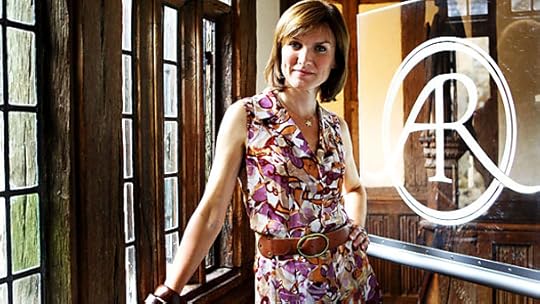
Fiona Bruce on the Antiques Roadshow
The Antiques Roadshow play along is back on Red Button. Fiona Bruce and the team assemble in Chatham's historic dockyard for another busy day uncovering stories behind family treasures. You can guess the valuations of objects featured in real time and find out if you’re an antiques expert or novice when your score is ranked.
You can now also play along on a mobile or tablet by downloading the play along app. Find out more and read the step-by-step instructions. Don't forget to tweet your scores to #antiquesroadshow.
Available on Sky and Freeview:
Sunday 17 March, 7.25pm-8.30pm
BBC Introducing Musicians’ Masterclass 2013
Highlights of a UK-wide day of Masterclass sessions designed to help unsigned acts navigate through the music industry. Featuring Zane Lowe, Wretch 32, Jo Whiley, Huw Stephens and the Manic Street Preachers.
Available on Freesat/Sky/Virgin Media/Freeview:
Thursday 21 March, 7pm-6am
Friday 22 March, 6am-12pm, 1pm-7pm, 9pm-6am
Sport highlights
It's a busy weekend for BBC Sport and on Saturday you can keep up with the live World Figure Skating Championships from Ontario, Canada as well as the highlights.
On Sunday catch up with the weekend's main events - watch the Australian Grand Prix replayed from 4.20pm to 7.25pm and again after the Antiques Roadshow play along from 8.30pm.
You can also catch Six Nations highlights on Red Button from noon on Sunday. As usual football fans can also get their weekly serving of the Final Score and the Football League Show across the weekend.
Available on Freesat/Sky/Virgin Media/Freeview.
For the latest information refer to the BBC Sport website
Please note - all Red Button times are subject to change at short notice.
Asian Network Gold 2013
The BBC Asian Network plunges into the BBC Archive to present a compilation of compelling and nostalgic Asian music and interviews from over four decades.
Asian Network Gold celebrates 100 years of the Indian Film industry by delving into the archives and unearthing some iconic interviews and performances from some of the biggest stars who featured on the BBC since the 1970s.
Available on Freesat/Sky/Virgin Media/Freeview:
Tuesday 19 March, 1pm to Thursday 21 March, 8.25am
Thursday 21 March, 4pm-6pm
In It To Win It Play Along
Attention quiz addicts! Dale Winton's In It To Win It, the game show where people use their general knowledge to win a big-money jackpot, is back. Think you can do better than the studio contestants? Every Saturday press the Red Button during the show to pit your wits against our studio contestants.
Available on Sky and Freeview:
Saturday 16 March, 8pm-8.50pm
Links: Microsoft and 90 years of BBC innovation
Hi folks - here’s the fortnightly round-up of news about BBC Online.
The announcement of a new partnership between the BBC and Microsoft received lots of attention across blogs last week. As reported by Cnet:
“You'll soon be able to watch catch-up and on-demand TV shows and films from Auntie Beeb on your Windows Phone phone, whether it's running Windows Phone 7.5 software -- like the Nokia Lumia 800 -- or Windows Phone 8 -- like the Nokia Lumia 920 and HTC 8S. It's not technically an app, but a shortcut that gets its own coloured square, or live tile, leading directly to the iPlayer online player. The launch date is yet to be confirmed.”
In order to see this content you need to have both Javascript enabled and Flash Installed. Visit BBC Webwise for full instructions. If you're reading via RSS, you'll need to visit the blog to access this content
90 years of innovation at the BBC
Yesterday BBC Marketing unveiled their Innovations campaign which celebrates 90 years of innovation at the BBC with a timeline and this short film:
As The Drum reported, the cross-media campaign seeks to highlight that the BBC as an organisation is constantly innovating with a public purpose:
“Using a combination of footage from the BBC archive, adapted and shot scenes as well as animation and CGI, the creative takes the viewer on a journey of broadcast, technological and creative advances from 1922 to the present day.”
The Guardian discussed the rapid growth of iPlayer viewing on tablets:
“BBC statistics for iPlayer viewing and listening have provided evidence of the impact of the so-called "tablet Christmas", with programme requests on devices such as Apple's iPad and Google's Nexus 7 almost doubling between November and January to 40m.”
CMU have reported on the decision to close the album reviews website and discuss what this means in the wider BBC Online context:
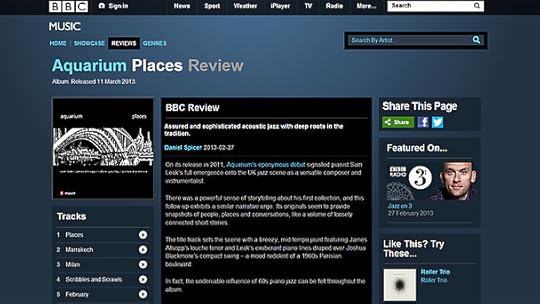
The BBC Music Review site
“The BBC has been quietly downsizing its online operations for sometime now. Partly to save money, and partly amidst pressure from commercial newspaper and magazine owners who argued that the BBC website that emerged in the early days of mainstream net usage, with large quantities of text-based features not directly linked to the Beeb’s TV or radio shows or the BBC News machine, took the Corporation outside its remit as a licence-fee funded broadcaster. The BBC’s online output is therefore increasingly directly linked to TV and radio output, and increasingly centres on audio and video rather than long-form written content. In this environment, the future of the BBC music reviews site had been uncertain for a while.”
Head of Digital Partnerships Bill Thompson gave this lunchtime lecture on Building an Open Digital Space at the Open Data Institute and discusses how the BBC could use and think about archive content in the future.
Digital Spy has an interesting feature on the evolution of YouView:
“YouView has had a very difficult birth and it's not out of the woods yet. Those sales figures need to start picking up, and the platform must truly convince consumers of its relevance in the same way that Freeview and Freesat have done. The fact original Project Canvas director Richard Halton has remained with the venture as chief executive will be an important factor in both those aims. But what we are beginning to see are the green-shoots of the platform that was initially heralded in the Canvas days; one that could quietly revolutionise the way the masses watch and consume TV.”
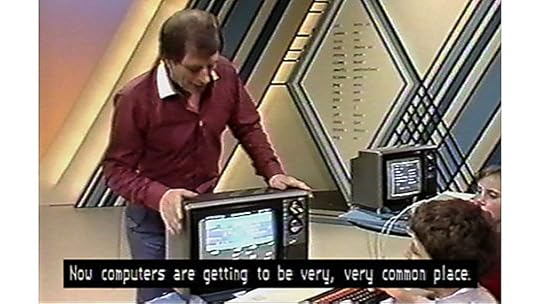
Johnny Ball grasps the future in the BBC Innovation campaign
Finally, BBC R&D have announced the imminent closure of their current blog and the launch of their new website:
“In the weeks to come you can look forward to a brand new R&D website, and within that a dedicated project updates feed, where we'll take all the content that we have hosted on this blog over the last three and a half years and integrate it with the project pages, departmental info, and the publications. All of this will have its own dedicated search function, independent of the wider BBC web search tool.”
You will be able to find out more about R&D’s new website on the Internet blog in the next few weeks.
That’s all for this week, have a great weekend and as ever please leave your comments below.
Eliza Kessler is the content producer on the BBC Internet blog.
Social Media at the BBC: Bridging the gap between audience and production
I’m Rowan Kerek Robertson, editorial lead for Social Media in BBC Vision.
My job, along with a small team, is about helping to ensure that the BBC’s TV programmes and channels use social media in ways which are as useful, entertaining and engaging as possible be it on BBC Online like the TV blog and other blogs, or in places like Twitter, Facebook or flickr.
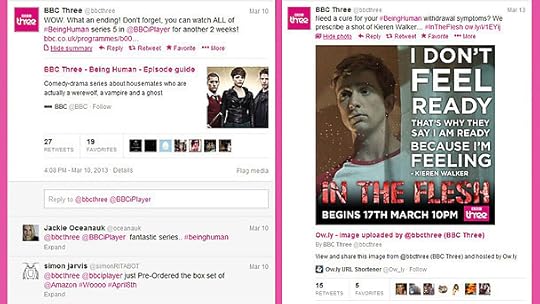
Tweets from BBC Three
My team and I are dedicated to bridging the gap between BBC producers and production teams and BBC audiences by using the social web.
The BBC as a whole has a strong tradition of engaging with audiences and a long history of using social media (relatively speaking…).
In the past I often found myself talking to producers about the differences between broadcasting and conversation. Broadcast is, of course, a one way route but conversation requires you to not only speak but also to listen.
But now more and more producers are getting used to social spaces such as Facebook, Twitter and photo sharing services like Instagram, Pinterest and flickr.
This means that our main challenge is now less about helping producers understand the nuances of social media but working together with people like our colleagues in BBC Marketing to think about what we do and how we’re going to do it.
It’s the same challenge that meets every user of social media: if you can talk to the world about anything and everything that you do, how do you make sure it is interesting?
In order to see this content you need to have both Javascript enabled and Flash Installed. Visit BBC Webwise for full instructions. If you're reading via RSS, you'll need to visit the blog to access this content
Watch the Queen Vic bust give her annual address to the nation...
In Vision’s Social Media team we help producers to get the most out of social in a number of ways.
We look at what content is coming up and which social platforms different types of audiences are using and help producers analyse activity that relates to programmes and brands as much as we can.
We then help production teams think about how much resource different kinds of social activity might require and the tone of voice or character their activity online might have.
Social media offers an increasingly elegant and effective way to ask people what they think, such as on the long standing Points of View message boards. It also helps people feed into our programmes in direct ways and to share extra content that isn’t part of what a linear programme can offer.
It can also help us get TV programmes and related content to people who might otherwise not have been aware of it.
The wide ranging output of my part of the BBC never ceases to amaze me. TV programmes which are so familiar that their theme tunes play in the nation’s subconscious like Eastenders and Strictly alongside series which mark the passing of the year like Springwatch, Eurovision and Comic Relief and brands which aren’t on TV but live primarily online such as Your Paintings, BBC Nature or BBC Food.
Because of the wide and diverse range of content there’s no one-size-fits-all solution to social media activity.
For Eastenders it’s all about sharing brilliant content and extending the programme for its real fans. So the Eastenders blog is full of photo spoilers and fun additional content like Queen Vic’s Speech 2012 delivered by the Queen Vic bust herself.
And alongside their official accounts on Facebook and Twitter (which have 2.9 million and 300 thousand followers respectively) you can also find fictional accounts from Eastenders characters popping up, like the one from cheeky chappie Fatboy who is followed by 30 thousand on Twitter. Those with an eagle eye will occasionally see references to his activity in the programme.
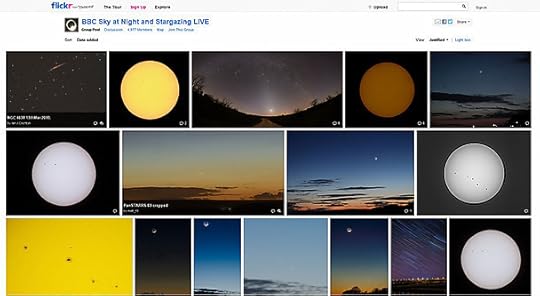
Stargazing LIVE and The Sky at Night flickr group
Stargazing Live is a lovely example of a BBC programme that’s using social media primarily to talk with its audience.
A panel of experts has taken part in live web chats during each series so far, answering peoples’ space-related questions as well as sharing behind-the-scenes photos and facts.
Stargazing and The Sky at Night also share a flickr group, which is crammed full of people sharing their honestly mind blowing photos. The group has five thousand members and 30 thousand photos which are well worth a few minutes of your time.
And as well as their support of projects like Zooniverse (you can literally help to map parts of Mars that you’ll be the first human to ever set eyes on) you can, from this series, follow them on Twitter along with 27 thousand others.
Perhaps because of the hardware divide between watching telly and being online, albeit a divide which is lessening all the time, UK television channels by and large haven’t been terribly big names in the social world.
Naturally it has been the younger channels which have led the way. For us, BBC Three has been digitally engaged with their audience for several years.
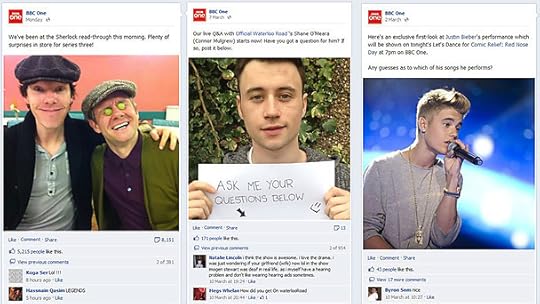
BBC One on Facebook
BBC Three’s social media offers on Facebook (532 thousand fans) and Twitter (140 thousand followers) are great ways of staying across the wealth of new programmes that the channel puts out, as well as voicing your opinions about their thought provoking shows.
BBC One has recently launched itself into the social whirl of Facebook too. BBC One’s Facebook page, currently with 33 thousand fans, is all about sharing the love for some of the nation’s favourite telly.
You can also check out and like images of the first televised coverage of the Olympics Games, the first ever Children In Need and of course the inception of Trotter’s Independent Traders.
We’re also seeing more and more TV programmes bringing social activity right into the heart of live shows like Free Speech on BBC Three which includes audience reactions from social media within debate on the programme itself.
This is done all the time in BBC radio but on TV it can take considerable planning due to the scale of TV productions.
If you’ve participated in any of the social spaces I’ve talked about in the post I’d be really interested in your thoughts.
Rowan Kerek Robertson is editorial lead for Social Media in BBC Vision.
March 8, 2013
What's on BBC Red Button 9th – 16th March
This week Red Button gears up for Red Nose Day before joining in on the main event on Friday 15 March. And there's live coverage and highlights of this weekend's Six Nations rugby.
Comic Relief 2013

Claudia Winkleman, Dermot O'Leary, Lenny Henry, Alan Carr, Rob Brydon, Michael McIntyre
Leading up to Red Nose Day 2013 we have five days of Comic Relief related treats for Red Button viewers.
From Monday 11 March we begin to look back over 25 years at the best of Red Nose Day with the help of some familiar faces from Comic Relief and BBC Radio 2. We'll also be sharing sneak peeks of some brand new sketches that will appear in full on BBC One on Friday 15 March. Come back to Red Button each day this week for new sketches and more of the funniest moments from the archive.
On Thursday 14 March The Radio 1 Breakfast Show will also be live on Red Button as Nick Grimshaw and a host of special guests aim to raise as much money as possible for Comic Relief.
Finally, on Friday 15 March tune in from 5.30pm as Miranda Hart aims to complete her final Mad March challenge in aid of Comic Relief. Miranda will be set a new challenge live on The Chris Evans Breakfast Show each day this week.
For more about this year’s fundraising efforts go to bbc.co.uk/rednoseday
Available on all platforms:
Mon 11 March, 12pm-6am
Tue 12 March, 6am-7.45pm, 10.45pm-6am
Wed 13 March, 6am-6am
Thu 14 March, 6am-6am
Fri 15 March, 6am-12pm, 2pm-6:.5pm
Sport

English rugby union's Chris Robshaw
This weekend on the Red Button you can watch extended highlights of the day's Six Nations Rugby - Scotland v Wales and Ireland v France (the matches are live on BBC One,starting at 2pm). On Sunday, unbeaten England continue their quest for a Grand Slam: we're offering alternative 5 live commentary of the England v Italy match live via the Red Button.
There’s also Final Score on Saturday afternoon and the Football League Show from early Sunday morning. For the latest information see the BBC Sport website and the BBC Red Button schedule. Times subject to change at short notice.
Asian Network Gold 2013
Asian Network Gold celebrates 100 years of the Indian film industry by delving into the archives and unearthing some iconic interviews and performances from some of the biggest stars who featured on the BBC since the 1970s.
This special programme charts the journey of how Bollywood became the largest film industry in the world from the first ever film shown in 1913. It features interviews from Bollywood's leading stars from legends including Rajesh Khanna, Raj Kapoor and Dilip Kumar to recent celebrities such as Shah Rukh Khan, Madhuri Dixit, Sri Devi, Anil Kapoor and Salman Khan who took the industry global.
Available on all platforms:
Sat 9 March, 6am-2.30pm
Sun 10 March, 12pm-2.20pm, 10.30pm-6am
In It To Win It PAQ
Dale Winton's In It To Win It, the game show where people use their general knowledge to win a big-money jackpot, is back. Think you can do better than the studio contestants? Every Saturday press the Red Button during the show to pit your wits against our studio contestants.
Available on Sky and Freeview:
Sat 9 March, 8:.5pm-9.15pm
Your Paintings: Searching the nations art
Hi I'm Nat Smith a freelance digital project manager. I helped co-ordinate the creation of the Your Paintings site.
My colleague Nick Cohen blogged about the public beta launch of Your Paintings in 2011.
Now the digitisation and publishing of the paintings is complete, we thought it would be a great time to look back on how the Your Paintings site was put together and share some of the thinking and approach used for the creation of the site.
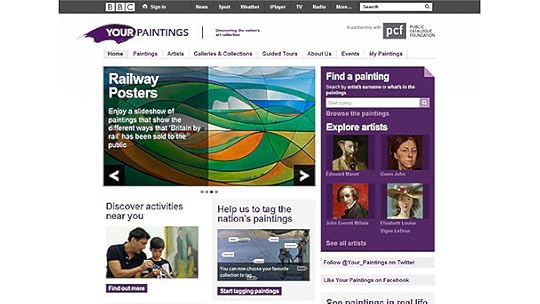
What is Your Paintings?
Before going any further I should explain what Your Paintings is.
The Your Paintings website contains images of all the UK's oil paintings supported by public funding. It is a vast collection of over 200,000 paintings, well 211,879 to be exact, from famous pieces such as The Fighting Temeraire to yet to be discovered gems.
The paintings don’t just reside in galleries and museums, they are also in many unusual locations such as fire stations.
Your Paintings was built in partnership with the Public Catalogue Foundation (PCF) who photographed and catalogued the paintings which enabled us to put them online.
The Hidden Paintings
These paintings are an incredible cultural asset for the UK yet only around 20% of them are on display at any one time, there is simply not enough wall space to display them all. Many of the paintings are in permanent storage, accessed only by researchers by special request.
One of the main goals of Your Paintings was to right that wrong, to provide the facility for everyone to engage and enjoy the paintings they fund.
Unknown unknowns
Another surprise is how little data existed for the paintings. For many the artist is unknown as is other information such as the title and date it was painted.
Where information did exist it tended to be only for the most frequently displayed paintings, not the 80% in storage.
Large number of images
One of the core principles of the website was for it to be accessible to anyone, regardless of their knowledge of art history.
So we have a large set of images with a small amount of data associated with them. How can this be presented so a non-art enthusiast can both engage with and use the site? How can someone browse over 200,000 images?
These were the first questions to answer.
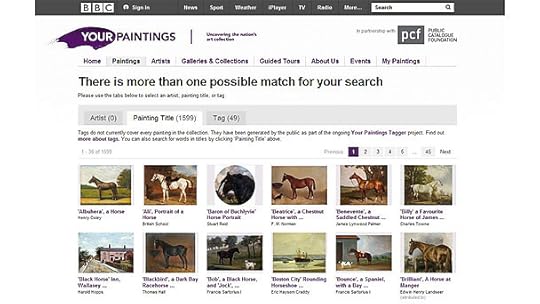
Searching for images in Your Paintings
User Research
User research underpinned the thinking behind the Your Paintings website.
From direct audience research we saw that people really wanted to know more about oil paintings but expressed they did not feel they knew enough about art or art history to engage with the subject.
We looked at how people approach art, both in physical spaces and on the web. We also looked at how people search for images generally on the web, looking at sites such as flickr, gettyimages, Google Images and analysing image search terms.
We also looked into the world of online shopping. Many shopping sites are trying to present a large catalogue of items that need to be easily searched and browsed just like the Your Paintings site.
It would be impossible to condense all the research into one blog posting but here are two key findings.
1. People rarely search for titles, they search for content based on subject.
2. Faceted search is one of the most effective ways to enable search by content.
From the insight into search data we saw only a small number of artists are searched for by name and an even smaller number of paintings are searched for by title.
Looking at research data for general image searching we saw people are looking mainly for image content. Examples of this are ‘Dogs’, ‘Boats’, ‘Winston Churchill’, ‘Matlock’, ‘The Great Fire of London’, or put another way Things, People, Places, Events and Subjects.
Therefore, to open up this collection of paintings we decided this set of images needed to be accessible via searches against Things, People, Places, Events and Subjects in addition to the typical information stored against paintings such as Artist, Painting Title, Style and Type.
The user would not need to know artist names or painting titles to find paintings that could interest them.
Research into online shopping showed us that faceted search is one of the best ways to browse through large collections of images.
To understand faceted search imagine you are shopping for a coat online. Perhaps you would start your search with the term ‘men’s coats’. The shopping site would then present the facets, or attributes associated with coats for example size colour, style and brand name.
The search could then be narrowed to medium, brown coats for winter made by Acme Corporation. The search could then be enlarged to show for example both brown and blue coats.
If you have used many online shops you will be sure to have seen faceted search in action.
The same could be true searching for images of paintings. For example you could start by looking for pictures of boats then narrow or enlarge the search based on paintings facets such as People, Places, Events, Styles, Types and Artist. Pictures of boats in Whitby anyone?
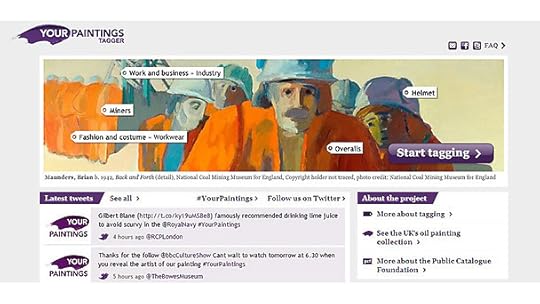
The Your Paintings Tagger
How can this be done?
As mentioned previously very little data, or metadata (data about data content), was available for the majority of the images. How could enough metadata be associated with each image to enable a faceted search?
We found the answer using the wisdom of the crowd.
Many Hands make light work
We looked around for websites which had tackled similar a problem in classifying large data sets. We sought advice from the Citizen Science Alliance and technical director Arfon Smith was incredibly helpful in advising and assisting with the solution.
Their approach is simple in concept and incredibly powerful. It is based on statistical probability. For example if you show an image to a large number of people and most of those people state there is a lighthouse in the image then in all likelihood there is a lighthouse in the image.
The thresholds can be adjusted in terms of the number of people you need to look at the image and the number of those that need to identify the object.
The product of this was the Your Paintings Tagger.
Tagger
The Your Paintings Tagger website is used to create the metadata underpinning the faceted search on Things, People, Places, Events and Subjects in the Your Paintings site. Users can log on and tag images with keywords associated with the content of the painting.
Try this for yourself, you don’t have to be an expert to do this anyone can get involved. Your help is still needed. If you have the time and interest please do take part in the Your Paintings Tagger, the more tagging that is done the richer the faceted search becomes.
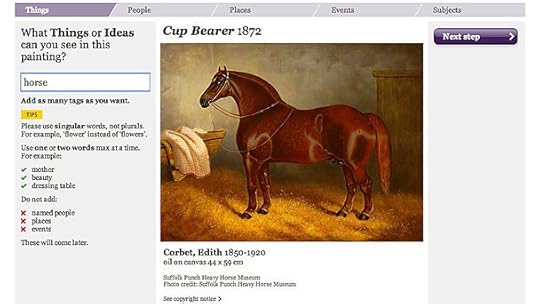
Tagging in the Your Paintings Tagger
The metadata captured by the Tagger is processed by the Tagger engine and sometime later transferred across to the Your Paintings database of metadata to support a search.
I hope this blog post gives some insight into the thought and mechanics behind the Your Paintings website.
Please get in touch, we welcome your comments and questions, we will try to respond to as many questions as we can.
Nat Smith is a freelance digital project manager.
March 7, 2013
Reporting Hurricane Sandy: Technology from The Edge Group
Hi, I’m Tim Harness the lead technologist working on the BBC Edge Group.
The Edge is a forum within the BBC for programme makers, journalists, engineers and technologists who want to find new, different, innovative and/or low-cost ways of getting audio and video from recording or filming locations back to the studio.

Laura Trevelyan reporting on Hurricane Sandy. The bonding device can be seen hanging from the tripod
We meet up every couple of months with members from all corners of the BBC, contributing and sharing ideas and experiences.
Our members are always on the lookout for new devices or systems and scour broadcasting and mobile trade shows for the next break-through in technology.
It's often the small suppliers round the edges of the exhibition halls that have the most interesting and innovative devices.
For some new technologies there are usually several manufacturers supplying competing devices.
The Edge group enables the BBC to evaluate these devices, finding out what best meets our needs and then provides a platform to share these results. This enables our production teams to do what they do best with the right technology.
The Edge Group are actively pushing forward into new territory and testing out new equipment in the field.
The revolution in mobile smart technology is having as much of an impact on broadcasting as it is on our personal lives and we want to get hold of those gadgets and try them out!
For example, in 2011 we tested out some 3G bonding devices. These can aggregate, or 'glue', a number of mobile data connections together and enable high quality video to be broadcast from a camera out on location instead of using a truck with a satellite dish on the top of it.
This technology was used very successfully for the seventy day Olympic Torch Relay. But it really came of age during our coverage of Hurricane Sandy in New York.
In the build-up to the storm, due to high winds it wasn't safe for our news team to use a satellite truck. Instead they were able to use a bonding device the size of a lunchbox that we'd just started trialling.
This enabled them to use the 4G networks around New York and New Jersey and it worked very well. It enabled us to be more mobile in the aftermath as well as broadcast live interviews with our reporters when most other broadcasters could not.
Similar devices were later used while reporting on the US Elections in Miami and Madison.
4G is now in the UK and there is a lot of interest in the potential of bonding devices from different parts of the BBC because it is potentially much smaller, cheaper and more flexible than conventional equipment.
What’s coming next?
We are very interested in mobile phone apps that can be used like a live broadcast camera.
With 4G spreading throughout the county and wi-fi being available in many public areas there is enough bandwidth to get some really good pictures and sound.
Cameras and mobile phones are converging and offering new opportunities in portable, lightweight news gathering. You can rest assured that the Edge will be trying it out!
Tim Harness is lead technologist for The Edge Group.
March 5, 2013
BBC iPlayer on mobile
I'm Dave Price, head of BBC iPlayer.
Last month I wrote about iPlayer’s record breaking festive period with incredible performance driven by new mobile and tablets unwrapped on Christmas Day.
And it seems even with a return to work and school, these new devices have yet to be put down.
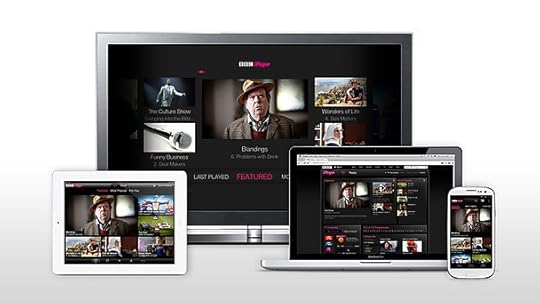
Last week we published the iPlayer performance pack for January which proved to be an exceptional month for TV programmes on iPlayer with 212 million requests across all devices and platforms, up +46% year on year.
However, it was TV requests from mobiles and tablet devices that rocketed in January, up +32% in just one month from December.
Popular programmes in January included Africa with 2.2 million requests for the first episode together with the return of Top Gear and Miranda with 1.8 million requests for some episodes.
And interestingly, for the first time ever we saw CBBC programmes regularly topping the daily most watched list with The Dumping Ground proving hugely appealing.
To date the BBC iPlayer app has been installed almost 15 million times on mobile and tablet devices.
With this many installs, it is no surprise that the growth in TV viewing in iPlayer has been driven by incredible tablet usage. Or should I say ‘phablets’?
And usage didn’t just peak over the festive period as can often be the case. Requests from devices with seven-inch screens such as the Nexus 7, Kindle Fire HD, Samsung Galaxy Tab and iPad Mini have continued to rise dramatically throughout January.
These stats reinforce the fact that mobile and tablets are hugely important platforms for iPlayer – ensuring you can watch and catch-up on your favourite BBC programmes whenever and wherever you are.
But while we can often use the same technologies to power a large number of devices, some older devices require specific implementations which have an on-going cost.
That said, we want to make our services available to as many people as possible so there’s always a balancing act.
With this in mind we have decommissioned iPlayer on a number of older devices which last week represented 0.17% of our total iPlayer use on mobile.
The full list can be found on the BBC iPlayer FAQ pages but include older Blackberry, Nokia, Samsung, Sony Ericsson and other mobile phones.
Equally we are always looking at new devices we can bring iPlayer to and I have good news! Earlier this month we added support to the iPlayer mobile web site for the new Blackberry Z10.
I am also thrilled to announce that we have also been working with Microsoft and within the next few months we'll be enabling the same mobile site for devices running Windows Phone 7.5 and 8.
My colleague Cyrus talks about this in his post.
This is really exciting news and I’m looking forward to sharing more with you at launch. In the meantime it’s always great here from you, so please share your thoughts and comments below.
Dave Price is the head of BBC iPlayer, Programmes and On Demand, BBC Future Media.
Mobile partnerships at the BBC: Microsoft
As mentioned in my post yesterday, in Business Development at the BBC we partner with a range of companies in the digital and technology space to keep the BBC at the cutting edge of emerging communications, technologies and services.
As well as using ‘behind the scenes’ technologies and working with companies to enhance our own products we also partner with device manufacturers and platforms to reach as wide as possible an online audience in the UK.
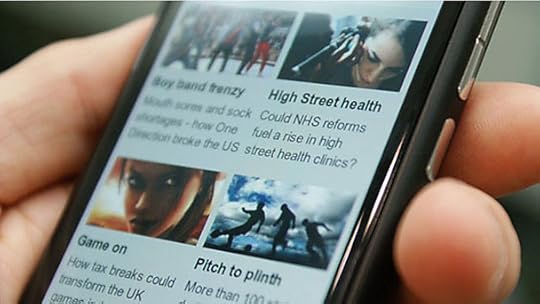
Mobile is increasingly important as a way for our audiences to access our services. BBC iPlayer and BBC News are already available on Apple (iOS), Android and Blackberry platforms.
Today I can let you know that we have signed a deal with Microsoft that will enable us to bring BBC iPlayer to the Windows phone platform.
We will be releasing a shortcut to BBC iPlayer in the near future which will be available in the Windows Phone Store, enabling the BBC iPlayer website to work on Windows Phone 7.5 and 8 via a live tile.
This shortcut will wrap the BBC iPlayer mobile website together with our media player. Hopefully these and other developments will help to expand our online reach further. Our latest figures show that over 650 different device types can access BBC iPlayer.
Working with the industry in ways like this helps our digital services reach more of the UK’s online population and gives our audiences ever increasing ways to access BBC services.
We will keep you updated on the launch and more in the coming months on the blog and elsewhere.
Cyrus Saihan is head of Business Development, BBC Future Media.
BBC's Blog
- BBC's profile
- 28 followers



